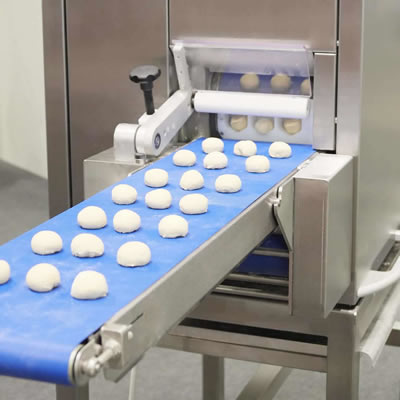
Dough Dividing
What is dough dividing?
After mixing, dough dividing is the next step in a bread production plant. Dough dividing implies the transformation/portioning of bulk or large masses of dough into countable or single pieces of dough that can be better handled and/or manipulated throughout the production line. Dough dividing is also the first step in the make-up stage.
It can be carried out manually or mechanically to consistently produce:
- Desired dough size
- Correct dough shape
- Set dough weight
- Dough texture for entry into the rounding step1
How does dough dividing work?
Dough pieces are divided volumetrically. This means, the bulk mass of dough is conveyed via a screw feeder. The rotating speed of the screw or dough pump determines the rate or mass flow of dough to be divided. The volumetric processing makes dough consistency and density vital factors for a accurate operation.
The dough is cut or divided into single pieces either by:
- Filling a chamber or barrel with a bulk mass of dough, and then cutting off and pushing the excess (piston dividing)
- Forcing a bulk mass of dough through an orifice at a fixed rate, and cutting protruding pieces from the end at regular intervals (extrusion and knife dividing)2
The specific weight of the dough pieces are usually set 13–15% heavier than the finished product weight to compensate for:1
- Fermentation losses caused by yeast metabolism
- Baking losses due to evaporation of water and ethanol solutions
- Losses during cooling due to evaporation of water
This is a key adjustment since the product must comply with labeling regulations and conform with in-house weight checks before being shipped to customers.
Dough dividing is essential for the production of yeast-leavened bakery products such as:
- Buns
- Rolls
- White pan bread
- Whole wheat pan bread
Dough dividers intended for high-speed or large-scale production bakeries are equipped or fitted with automatic weight-checking mechanisms to check the dough at the beginning, middle, and end of each batch, or monitoring weight in a continuous fashion.
The running speed of dough dividers can be set manually by a human-machine interface (HMI) or centrally pre-set, according to the production line speed.
Common adjustments to dough dividers include:
- Conveying speed of screw or dough pump
- Conveying speed of belt
- Cuts per minute or knife speed
- Amount of pressure in the chamber or barrel (using manometer reading)
Equipment used for dough dividing
- Rotary/extrusion dividers
- Piston dividers
- Ram and knife dividers
- Pocket dividers
- Stress-free dividers
Bulk dough conveyed by a belt, sheeted to a certain thickness, and then cut lengthwise to produce a series of long ribbons. These are then gently portioned and rounded in the same piece of equipment. Stress-free dividers reduce or minimize the mechanical stress and strain forces that dough usually withstands during dividing.
Food safety and quality considerations
- Dough dividing equipment, as any other product-contact surface, should allow for maintenance, inspection, cleaning and sanitation activities to be performed easily, adequately and quickly.
- The amount of incoming bulk dough that divider can process should be appropriately balanced against the divider output to reduce dough shrinkage.
- The mass of dough being divided, should not be allowed to stand more than 20 minutes in the divider hopper or chute without making it to the rounding step.1 This is particularly important in bakeries in which bulk fermentation does not occur, but only a specified floor time. As time passes, yeast activity, or carbon dioxide production, continues and could cause variations in dough density and weight distribution.3
- If dough is held for prolonged periods of time without being divided, it runs the risk of becoming too gassy and warmer than the desired temperature.
References
- AIB International. Bread Manufacturing Process, Distance Learning Course, “Part 2 Module 01 – Dividing.” https://www.aibonline.org/Start-Your-Training/Baking/Baking-Foundations/Bread-Manufacturing-Process-Online, 2018.
- Cauvain, S.P. “Mixing and Dough Processing.” Technology of Breadmaking, 3rd ed., Springer International Publishing Switzerland, 2015, pp. 119–121.
- Cauvain, S.P. “Raw Materials.” Baking Problems Solved, 2nd ed., Woodhead Publishing, Elsevier Ltd., 2017, p. 127.

